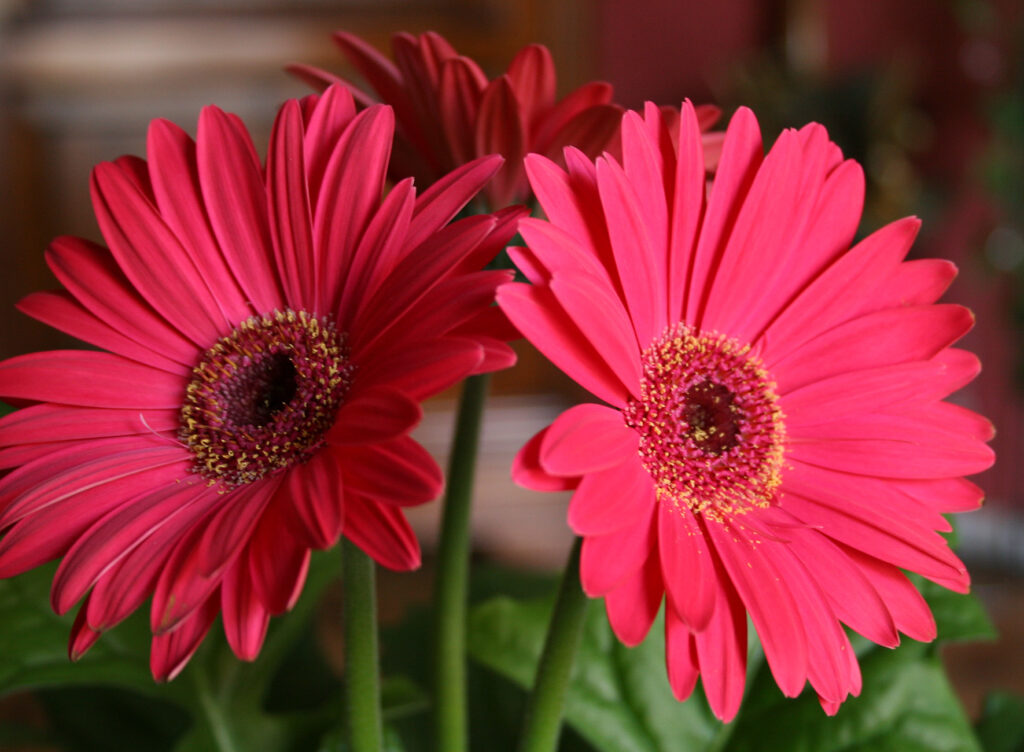
Gerbera daisies (Gerbera jamesonii) are bright, colorful flowers that are commonly planted in gardens as bedding plants or in containers in South Carolina. They are native to South Africa, are members of the aster family, and are also related to sunflowers and marigolds. The genus name, Gerbera was named in honor of the 18th-century German naturalist, Traugott Gerbera.
Characteristics
Gerbera daisies have long-lasting 3- to 4-inch flowers that come in numerous shades of yellow, white, pink, red, orange, lavender, salmon, and bicolored. The center floral disk can range from yellowish to light-bronze to black in color. Each flower is attached to a leafless stem that raises about 6 inches above the plant’s foliage, which is a tall 12-inch wide clump of long, slightly “fuzzy” leaves. Gerberas produce flowers from late spring through autumn in the garden, and their blooms make long-lasting cut flowers. Gerbera daisies typically grow 6 to 18 inches tall.
Typically grown as annuals, gerbera daisies are tender perennials in the warmer parts of South Carolina. Gardeners in USDA plant hardiness zone 8 may have success growing gerbera daisies as perennials if the garden is mulched and the plants are protected from the freezing temperatures of winter. However, most homeowners plant gerberas as annuals each year or over-winter them indoors. Container grown gerbera daisies can be brought indoors for overwintering. Keep plants barely moist and cool (45 ° to 50 °F), and provide sun and good air circulation.
Planting & Care
Good soil drainage is important for growing gerberas because excessive moisture can lead to crown disease and root rot. If the soil does not have good drainage, consider growing the gerberas in containers or raised beds. Gerberas also like a soil enriched with compost. Their soil moisture needs are average once they have become rooted, but make sure the transplants get plenty of water when they are first planted.
Plant gerbera daisies in the spring after the danger of frost has passed. Space them 12 to 18 inches apart with the crown of the plant at or slightly above the soil level. The crown is the point where the stem and roots meet the soil. Due to the extreme summer heat in the South, gerberas grow best in areas where they receive morning sun and afternoon shade. When watering, avoid overhead irrigation to prevent the spread of foliar diseases. The crown should be allowed to dry out between waterings to reduce the risk of crown and root rots. Discourage fungal disease by watering early in the day so that the leaves can dry out before nightfall.
Mulch around the plants with a 2- to 3- inch layer of organic matter such as pine straw or pine bark to conserve soil moisture and reduce weed growth. Mulching helps reduce the need for mechanical and chemical week control.
Deadhead spent blooms and their stems down to the next stem, bud, or leaf to promote additional flowering.
Fertilizing
Fertilizing gerbera daisies is important to produce the best-looking plants. Apply a controlled-release fertilizer two to three times during the growing season or use a liquid fertilizer every two weeks. Gerberas can suffer from iron and manganese deficiencies, especially in potting soil; therefore, use a granular fertilizer or foliar fertilizer spray that contains these micronutrients.
